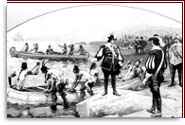
Samuel de Champlain: the French arrive at Chambly
Fort Chambly National Historic Site
 Champlain's Departure for the West
Champlain's Departure for the West© National Archives of Canada / Anonymous / C-6881
In 1603, Samuel de Champlain made his first trip to New France. Accompanied by St. Malo merchant Gravé du Pont, he visited the Tadoussac fur-trading post that had been set up in 1600. Once they had concluded their trade, the two Frenchmen headed up the St. Lawrence River to the rapids at Lachine and explored down the Iroquois River, later to become the Richelieu River.
This expedition convinced Champlain that France had to have a permanent base in the St. Lawrence Valley, since the river led to the heart of the country and would open the way to new lands to supply the fur trade. In 1608, Champlain founded Quebec, marking the beginning of a new era of trade and colonization.
To run the fur trade, the French first of all needed traders and also intermediaries from the Montagnais, Algonquin and Huron First Nations. They had to gain the confidence of the Indigenous and weave ties of trade with them. In 1609, Champlain consolidated his alliances when he participated in a raid against the Iroquois. He paddled up the Iroquois River and left a very interesting description of the rapids at Chambly:
"The approach to the rapids is a sort of lake into which the water flows down, and it is about three leagues in circumference. Near by are meadows were no Indians live, by reason of the wars. At the rapids there is very little water, but it flows with great swiftness, and there are many rocks and boulders, so that the Indians cannot go up by water; but on the way back they run them very nicely. All this region is very level and full of forests, vines and butternut trees. No Christian has ever visited this land and we had all the misery of the world trying to paddle the river upstream."
 "Defeat of the Iroquois at Lake Champlain"
"Defeat of the Iroquois at Lake Champlain"© National Archives of Canada / Anonymous / C-6881, 1613
On July 14, Champlain arrived at a huge lake to which he gave his name: Lake Champlain. His first encounter with the Iroquois was to the south of the lake. It was the superiority of the Europeans' arms that enabled the French and their allies to come out victorious from this, the first battle in what was to become a long series of conflicts with the Iroquois.
Champlain had just opened the way for the man who would later establish the first military post at the foot of the rapids at Chambly: Jacques de Chambly, captain of a detachment of the Carignan-Salières Regiment.
- Date modified :